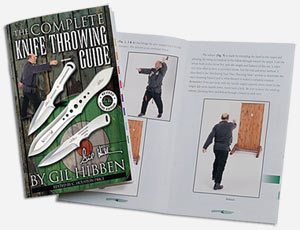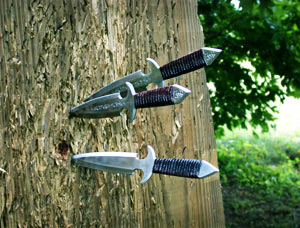Knife Throwing Guide
Considerations

Generations of men and women have enjoyed the exciting challenge of accurately and precisely throwing knives. It is a sport that dates to the early American pioneer days where it provided enjoyable recreational activities for all who participated. Today, in addition to providing an exciting outlet for recreation and sport, throwing knives also provides many other benefits such as mental relaxation and muscle stimulation for better body coordination and control. Knife throwing is also a great family recreational activity that allows family members to share in practicing knife safety as well as to teach future generations the exciting art of throwing knives.
Knife selection is a key component of successful knife throwing. The best characteristics to consider when choosing a knife for throwing are the length, weight, balance, shape, and design of the knife. Knife length provides control while knife weight provides force for throwing and accuracy. The shape and design of throwing knives are also particularly important when selecting a throwing knife. Ideally, throwing knives are not beveled, double-edged, or sharpened on each side. Additionally, balance is an important factor that determines how efficiently the knife is thrown. Balance is the indication of the knife's weight distribution, and is very important in maintaining accuracy when throwing a knife. Traditional examples of good throwing knives include most defense knives such as boot knives, daggers, bowies, fighters, and those designed specifically for throwing.
Selecting a target is also important in successful knife throwing. Targets can be purchased or constructed of many things. Some people construct their own large knife targets. Such targets can be mounted, suspended, or free-standing. Flattened cardboard boxes make a good target for throwing knives because the surface is soft but durable, and such boxes are very inexpensive or often free. Another possibility for a target is inexpensive sheathing materials used by contractors and builders, after being properly secured to to a sturdy backing. However, the material of choice for most seasoned knife throwers is a soft wood such as pine, birch, willow, poplar, redwood, or cypress wood. It is also important to note that trees do not make a good target for knife throwing because repeated strikes with a knife can cause severe damage to or total loss of the tree. Additionally, a tree can damage or completely break some knives.

Basic Skills
The manner in which the knife is held is paramount for efficiency, accuracy, and safety. The flat side of the handle should be firmly held, or seated, in the palm of the throwing hand. The heel of the handle should be securely gripped in the back of the palm, with the fingers wrapped around the handle, gripping the opposite flat side. Careful placement of the thumb is essential for successful knife throwing. The thumb often serves as a pointer and can be placed on the flat side of the handle, which also helps the fingers grasp the knife, or it can be placed on the top of the knife's handle.
Stance is the next important aspect of proper and successful knife throwing. A marker should be clearly drawn or indicated a comfortable and safe distance from the target, and the thrower should begin by stepping on said marker. With one foot behind the other and the knees bent slight, the thrower is ready for the wind-up, and the knife is ready for presentation. To do this, grasp the knife with both hands and extend them from the body, pointing the knife at the target, while stepping forward to align the corresponding foot with the dominant, or throwing hand.
After securing a proper grip on the handle of the knife, present it to the target in much the same way a bowler presents the bowling ball to the bowling pins. To initiate the wind-up, or back-swing, bring the dominant arm backward, past the head and over the shoulder, while extending the other arm toward the target, as if pointing at the target (this provides improved balance). This action should be done smoothly and carefully, with the plane of the blade pointing vertically. While still pointing at the target with the non-dominant hand, maintain the throwing hand in the throwing position, and execute the delivery swing. The delivery swing should be very smooth and deliberate, creating an arc as the knife is brought forward, continuing the swinging motion and dropping the non-dominant arm at this point, allowing it to swing back down. This swinging motion should continue until the knife reaches approximately eye level of the thrower, at which point it should be released.
When the knife has reached the precise point at which it begins its flight to the target, the grip should be released without making any wrist action or movement, which would alter the rotations of the knife, and could cause it to flip or stray from its intended path toward the target. A smooth release is imperative to successful and accurate throwing.
Finally, the follow-through of the swing is just as vital for knife throwing as it is in baseball, golf, horseshoes, etc. The follow-through should be an extension of the swinging motion, and is necessary to prevent the swing from stopping suddenly at the moment the knife is released. As with any hobby or sport, knife throwing takes careful and determined practice and concentration in order to become a skillful and seasoned thrower. For more information and a complete guide to throwing knives pick up a copy of master knifemaker Gil Hibben's Knife Throwing Guide book.